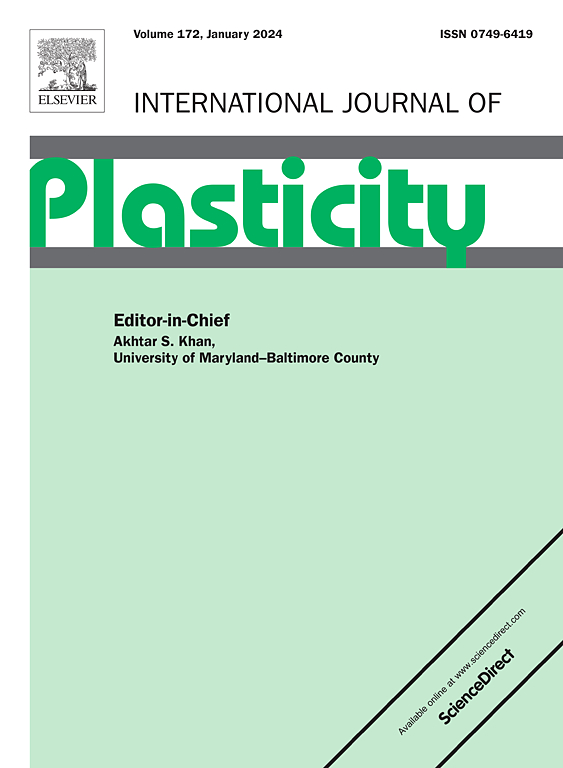A multi-physics model for the evolution of grain microstructure
IF 9.4
1区 材料科学
Q1 ENGINEERING, MECHANICAL
引用次数: 0
Abstract
When a metal is loaded mechanically at elevated temperatures, its grain microstructure evolves due to multiple physical mechanisms. Two of which are the curvature-driven migration of the grain boundaries due to increased mobility, and the formation of subgrains due to severe plastic deformation. Similar phenomena are observed during heat treatment subsequent to severe plastic deformation. Grain boundary migration and plastic deformation simultaneously change the lattice orientation at any given material point, which is challenging to simulate consistently. The majority of existing simulation approaches tackle this problem by applying separate, specialized models for mechanical deformation and grain boundary migration sequentially. Significant progress was made recognizing that the Cosserat continuum represents an ideal framework for the coupling between different mechanisms causing lattice reorientation, since rotations are native degrees of freedom in this setting.
In this work we propose and implement a multi-physics model, which couples Cosserat crystal plasticity to Henry–Mellenthin–Plapp (HMP) type orientation phase-field in a single thermodynamically consistent framework for microstructure evolution. Compared to models based on the Kobayashi–Warren–Carter (KWC) phase-field, the HMP formulation removes the nonphysical term linear in the gradient of orientation from the free energy density, thus eliminating long-range interactions between grain boundaries. Further, HMP orientation phase field can handle inclination-dependent grain boundary energies. We evaluate the model’s predictions and numerical performance within a two-dimensional finite element framework, and compare it to a previously published results based on KWC phase-field coupled with Cosserat mechanics.
晶粒微观结构演化的多物理场模型
当金属在高温下机械加载时,由于多种物理机制,其晶粒微观结构发生了变化。其中两种是由于迁移率增加而引起的曲率驱动的晶界迁移,以及由于严重的塑性变形而形成的亚晶。在严重塑性变形后的热处理过程中也观察到类似的现象。晶界迁移和塑性变形同时改变了任意材料点的晶格取向,这一过程的一致性模拟具有挑战性。现有的大多数模拟方法通过应用单独的、专门的机械变形和晶界迁移模型来解决这个问题。认识到Cosserat连续体代表了导致晶格重定向的不同机制之间耦合的理想框架,这取得了重大进展,因为在这种情况下旋转是固有的自由度。在这项工作中,我们提出并实现了一个多物理场模型,该模型将coserat晶体塑性与Henry-Mellenthin-Plapp (HMP)型取向相场耦合在一个单一的热力学一致的框架中,用于微观结构演化。与基于Kobayashi-Warren-Carter (KWC)相场的模型相比,HMP公式从自由能密度中去除了取向梯度线性的非物理项,从而消除了晶界之间的远程相互作用。此外,HMP取向相场可以处理与倾角相关的晶界能。我们在二维有限元框架内评估了模型的预测和数值性能,并将其与先前发表的基于KWC相场耦合Cosserat力学的结果进行了比较。
本文章由计算机程序翻译,如有差异,请以英文原文为准。
求助全文
约1分钟内获得全文
求助全文
来源期刊

International Journal of Plasticity
工程技术-材料科学:综合
CiteScore
15.30
自引率
26.50%
发文量
256
审稿时长
46 days
期刊介绍:
International Journal of Plasticity aims to present original research encompassing all facets of plastic deformation, damage, and fracture behavior in both isotropic and anisotropic solids. This includes exploring the thermodynamics of plasticity and fracture, continuum theory, and macroscopic as well as microscopic phenomena.
Topics of interest span the plastic behavior of single crystals and polycrystalline metals, ceramics, rocks, soils, composites, nanocrystalline and microelectronics materials, shape memory alloys, ferroelectric ceramics, thin films, and polymers. Additionally, the journal covers plasticity aspects of failure and fracture mechanics. Contributions involving significant experimental, numerical, or theoretical advancements that enhance the understanding of the plastic behavior of solids are particularly valued. Papers addressing the modeling of finite nonlinear elastic deformation, bearing similarities to the modeling of plastic deformation, are also welcomed.
 求助内容:
求助内容: 应助结果提醒方式:
应助结果提醒方式:


